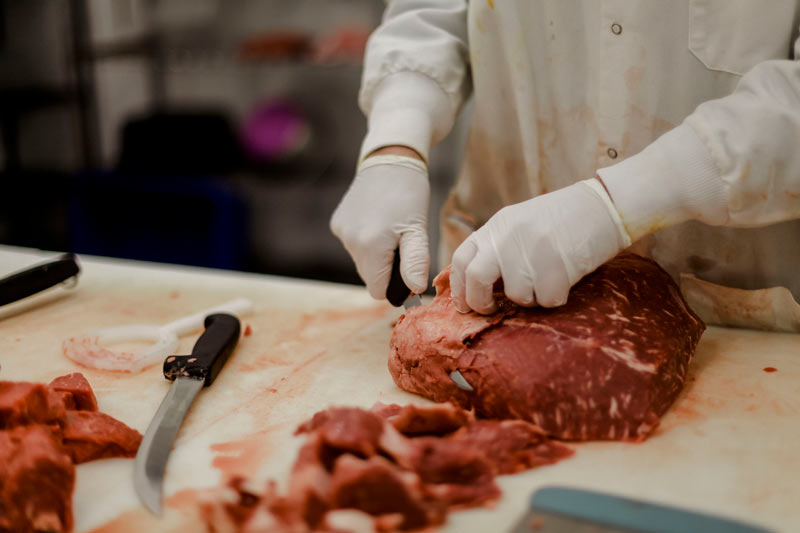Why Locals Love Bagley Farms Meat Market Edwardsville IL for Their Meat Shopping
Why Locals Love Bagley Farms Meat Market Edwardsville IL for Their Meat Shopping
Blog Article
Reveal the Art of the Butcher's Cut in a Modern Meat Market
In the ever-evolving landscape of modern meat markets, the butcher's cut has transcended its traditional roots, combining old-time workmanship with modern methods. Today's butchers are not simply processors of meat; they are well-informed artisans who stress sustainability and moral sourcing. Their expertise in selecting and preparing cuts customized to certain cooking requirements provides an unmatched eating experience. Yet, what genuinely sets the modern butcher apart is their ability to build a much deeper connection in between customers and the origins of their meat. How do these masters equilibrium custom with innovation, and what effects does this have for the future of meat usage?
Evolution of Butchery Strategies
The evolution of butchery strategies shows an abundant tapestry of development and adjustment driven by developments in modern technology, modifications in customer demand, and a much deeper understanding of meat science. Historically, butchery was a craft gave via generations, with techniques sharpened over centuries to maximize yield and taste. However, the commercial revolution ushered in automation, transforming conventional techniques and enabling massive handling.
The mid-20th century saw butchery strategies further fine-tuned by clinical understandings into muscle biology and meat aging, improving both inflammation and preference. Innovations like vacuum packaging and refrigeration expanded item shelf-life, allowing butchers to expand offerings and improve high quality control. This duration additionally noted the surge of specialized equipment, such as band saws and meat slicers, which enhanced precision and effectiveness in meat handling.

The 21st century has actually presented electronic innovation right into the butchery realm. Electronic systems now aid in tracking animal provenance and optimizing cuts to meet specific consumer choices. In addition, a renewal in artisanal butchery has actually emerged, blending traditional skills with modern-day expertise to satisfy consumers seeking ethical and lasting meat alternatives. This evolution emphasizes a vibrant interplay between practice and technology, conference contemporary needs while maintaining the craft's heritage.
Recognizing Meat Cuts
Understanding the intricacies of meat cuts is crucial for both butchers and consumers seeking high quality and worth. For butchers, accurate cuts mirror skill and regard for the craft, making sure marginal waste and optimal yield.

Understanding muscle structure is crucial; muscles utilized a lot more regularly by the find pet tend to be tougher and are best fit for sluggish food preparation techniques, while less-used muscular tissues, like those located important source in the loin, are much more tender and suitable for barbecuing or roasting. Experience with these distinctions empowers customers to make enlightened options, boosting their cooking endeavors.
Picking Top Quality Meat
Selecting the ideal meat entails more than simply choosing a visually enticing item from the display screen. The art of selecting top quality meat requires a discerning eye and understanding of details features that signify freshness and excellence.
Secondly, think about the marbling, which describes the white flecks of fat within the muscle mass. Appropriate marbling is a key indication of inflammation and flavor, as it melts throughout food preparation, boosting the meat's juiciness. Bear in mind, greater marbling commonly associates with exceptional high quality cuts, such as USDA Prime.
Texture is an additional crucial element; meat needs to feel solid to the touch, not slimed or overly soft. Additionally, bear in mind the scent. Fresh meat should have a tidy, neutral scent, free from any sour or off-putting smells.
Combining Cuts With Food Preparation Methods

On the other hand, harder cuts like brisket and chuck roast are abundant in collagen, which breaks down right into gelatin when prepared slowly. These cuts are suitable for braising or slow-moving roasting, allowing the meat to tenderize in time and develop deep, complicated flavors. Cuts such as short ribs and pork shoulder get on well with slow-cooking approaches, where expanded cooking times transform their durable structures into delicious dishes.
Lamb shanks and oxtail, which call for long term food preparation to soften, are perfect candidates for cooking or slow simmering. These methods coax out rich, hearty flavors while maintaining dampness. By understanding the one-of-a-kind attributes of each cut, cooks and home chefs alike can elevate their culinary productions, making certain each meal is both satisfying and unforgettable.
The Butcher's Function Today
Browsing the advancing landscape of the contemporary meat market, the butcher's duty today prolongs past mere prep work of cuts. Contemporary butchers are culinary craftsmens, teachers, and supporters for sustainable practices.
Along with crafting precise cuts, butchers currently involve directly with customers, offering cooking suggestions and customizing choices to suit private needs and preferences. Their proficiency in meat aging, marbling, and flavor accounts encourages consumers to make educated decisions, additional resources boosting their cooking experiences. This individualized solution exhibits the butcher's developing duty as a trusted expert in the kitchen area.
Furthermore, butchers are crucial in minimizing waste, using whole pets to create varied items such as sausages and stocks. This extensive method not only values the animal yet additionally aligns with contemporary sustainability goals. This way, the contemporary butcher personifies both practice and innovation, adjusting to an ever-changing market while protecting the virtuosity and stability of their craft.
Conclusion
Proficiency in recognizing diverse meat cuts and high quality indicators encourages butchers to provide informed recommendations, lining up particular cuts with ideal food preparation approaches. By honoring historic practices while embracing modern needs, the butcher's function remains vital in today's innovative meat market.
Report this page